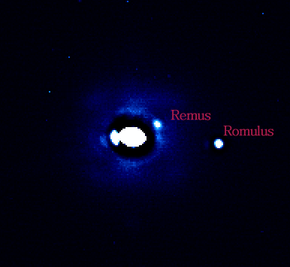Remus (moon)
 Adaptive Optics observations of (87) Sylvia, showing its two satellites, Remus and Romulus. | |
| Discovery[1] | |
|---|---|
| Discovered by | Franck Marchis, Pascal Descamps, Daniel Hestroffer, Jérôme Berthier |
| Discovery date | August 9, 2004 |
| Designations | |
| Sylvia II | |
| Pronunciation | /ˈriːməs/ |
Named after | Rēmus |
| S/2004 (87) 1 | |
| Main belt (Cybele) | |
| Adjectives | Remian /ˈriːmiən/[2] |
| Orbital characteristics[3] | |
| 706 ± 5 km | |
| Eccentricity | 0.016 ± 0.011 |
| 1.3788 ± 0.0007 d | |
Average orbital speed | 37.2 m/s |
| Inclination | 2.0 ± 1.0° (with respect to Sylvia equator) |
| Satellite of | 87 Sylvia |
| Physical characteristics | |
| Dimensions | 7 ± 2 km [3][a] |
| Mass | ~ 2×1014 kg (estimate)[b] |
Equatorial escape velocity | ~ 4 m/s (estimate) |
| unknown, probably synchronous[c] | |
| unknown, zero expected | |
| 11.1[3] | |
Remus is the inner and smaller moon of the main-belt asteroid 87 Sylvia. It follows an almost-circular and close-to-equatorial orbit around the parent asteroid. In this respect it is similar to the other Sylvian moon Romulus.
Discovery and naming
[edit]Remus was discovered several years after Romulus on images taken starting on August 9, 2004, and announced on August 10, 2005. It was discovered by Franck Marchis of UC Berkeley, and Pascal Descamps, Daniel Hestroffer, and Jérôme Berthier of the Observatoire de Paris, France, using the Yepun telescope of the European Southern Observatory (ESO) in Chile. Marchis, the project leader, was waiting for the completion of the image acquisition programme before starting to process the data. Just as he was set to go on vacation in March 2005, Descamps sent him a brief note entitled "87 Sylvia est triple ?" pointing out that he could see two moonlets on several images of Sylvia. The entire team then focused quickly on analysis of the data, wrote a paper, submitted an abstract to the August meeting in Rio de Janeiro and submitted a naming proposal to the IAU.
Its full designation is (87) Sylvia II Remus; before receiving its name, it was known as S/2004 (87) 1. The moon is named after Remus, twin of the mythological founder of Rome, one of the children of Rhea Silvia raised by a wolf.
Characteristics
[edit]87 Sylvia has a low density, which indicates that it is probably a rubble pile asteroid formed when debris from a collision between its parent body and another asteroid re-accreted gravitationally. Thus it is likely that both Remus and Romulus are smaller rubble piles which accreted in orbit around the main body from debris of the same collision. In this case their albedo and density are expected to be similar to Sylvia's.[3]
Remus's orbit is expected to be quite stable: it lies far inside Sylvia's Hill sphere (about 1/100 of Sylvia's Hill radius), but also far outside the synchronous orbit.[3]
From Remus's surface, Sylvia appears huge, taking up an angular region roughly 30°×18° across, while Romulus's apparent size varies between 1.6° and 0.5° across.
See also
[edit]Notes
[edit]- ^ Assuming the same albedo as Sylvia
- ^ Assuming same density and albedo as Sylvia
- ^ Based on a rough tidal locking timescale of several tens of My.
References
[edit]- ^ IAUC 8582, announcing the discovery of S/2004 (87) 1 and naming Romulus and Remus.
- ^ William Coe Collar (1891) The Gate to Caesar, p. 117
- ^ a b c d e F. Marchis; et al. (2005). "Discovery of the triple asteroidal system 87 Sylvia" (PDF). Nature. 436 (7052): 822–4. Bibcode:2005Natur.436..822M. doi:10.1038/nature04018. PMID 16094362. S2CID 4412813.
External links
[edit]- Data on (87) Sylvia from Johnston's archive (maintained by W. R. Johnston)
- Rubble-Pile Minor Planet Sylvia and Her Twins Archived 2008-07-24 at the Wayback Machine (ESO news release, August 2005) Includes images and artists impressions
- IAUC 8582, reporting discovery of S/2004 (87) 1 and naming Romulus and Remus
| Minor planets |
| ||||||
|---|---|---|---|---|---|---|---|
| Comets | |||||||
| Other | |||||||
Text is available under the CC BY-SA 4.0 license; additional terms may apply.
Images, videos and audio are available under their respective licenses.
